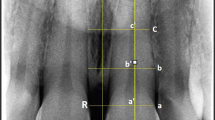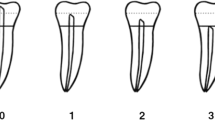Abstract
Age assessment may be a crucial step in postmortem profiling leading to confirmative identification. Among the traditional dental parameters used for estimating age, root dentin translucency is considered to be least affected by external stimuli and most suitable for the purpose. Using this variable, Bang and Ramm in 1970 developed an elaborate method and formulae for predicting age in Norwegians, and its efficacy has been examined in Indians. A total of 100 tooth sections 250-µm thick were obtained from as many subjects, scanned on a flat-bed scanner and the translucency length measured using a commercially available image-editing software program. Since age estimates in Indians was less accurate compared to the original sample, translucency measurements were subjected to regression analysis, and India-specific formulae were derived. The new formula was applied to a control group (n = 18), and the estimated age was marginally better, validating to some extent the use of population-specific formulae in forensic age estimation. However, moderate correlation of translucency length to age inherent in Indians may undermine optimal age prediction.


Similar content being viewed by others
References
Gustafson G (1950) Age determination on teeth. J Am Dent Assoc 41(1):45–54
Johanson G (1971) Age determination from teeth. Odontol Revy 22(21 Suppl):1–126
Demirjian A, Goldstein H, Tanner JM (1973) A new system of dental age assessment. Hum Biol 42:211–227
Helfman PM, Bada JL (1976) Aspartic acid racemization in dentine as a measure of ageing. Nature 262:279–281
Spalding KL, Buchholz BA, Bergman LE et al (2005) Age written in teeth by nuclear tests. Nature 437(15):333–334
Kvaal SI, Kolltveit KM, Thompsen IO et al (1995) Age estimation of adults from dental radiographs. Forensic Sci Int 74:175–185
Cameriere R, Ferrante L, Cingolani M (2004) Variations in pulp/tooth area ratio as an indicator of age: a preliminary study. J Forensic Sci 49(2):317–319
Cameriere R, Ferrante L, Cingolani M (2006) Age estimation in children by measurement of open apices in teeth. Int J Legal Med 120:49–52
Schmidt S, Nitz I, Schulz R et al (2008) Applicability of the skeletal age determination method of Tanner and Whitehouse for forensic age diagnostics. Int J Legal Med 122(4):309–314
Schulz R, Zwiesigk P, Schiborr M et al (2008) Ultrasound studies on the time course of clavicular ossification. Int J Legal Med 122(2):163–167
Cameriere R, Ferrante L, De Angelis D et al (2008) The comparison between measurement of open apices of third molars and Demirjian stages to test chronological age of over 18 year olds in living subjects. Int J Legal Med 122(6):493–497
Landa MI, Garamendi PM, Botella MC et al (2009) Application of the method of Kvaal et al. to digital orthopantomograms. Int J Legal Med 123(2):123–128
Schmeling A, Geserick G, Reisinger W et al (2007) Age estimation. Forensic Sci Int 165(2–3):178–181
Schmeling A, Grundmann C, Fuhrmann A et al (2008) Criteria for age estimation in living individuals. Int J Legal Med 122(6):457–460
Miles AEW (1963) Dentition in the estimation of age. J Dent Res 42(1 Suppl):255–263
Bang G, Ramm E (1970) Determination of age in humans from root dentine transparency. Acta Odontol Scand 28(1):3–35
Solheim T, Sundnes PK (1980) Dental age estimation of Norwegian adults—a comparison of different methods. Forensic Sci Int 16(1):7–17
Olze A, Geserick G, Schmeling A (2004) Age estimation of unidentified corpses by measurement of root translucency. J Forensic Odontostomatol 22(2):28–33
Ubelaker DH, Parra RC (2008) Application of three dental methods of adult age estimation from intact single rooted teeth to a Peruvian sample. J Forensic Sci 53(3):608–611
Whittaker DK, Bakri MM (1996) Racial variations in the extent of tooth root translucency in ageing individuals. Arch Oral Biol 41(1):15–19
Acharya AB (2009) A new digital approach for measuring dentin translucency in forensic age estimation. Am J Forensic Med Pathol (article in press)
Valenzuela A, Martin-De Las Heras S, Mandojana JM et al (2002) Multiple regression models for age estimation by assessment of morphologic dental changes according to teeth source. Am J Forensic Med Pathol 23(4):386–389
Brkic H, Milicevic M, Petrovecki M (2006) Age estimation methods using anthropological parameters on human teeth—(A0736). Forensic Sci Int 162:13–16
Foti B, Adalian P, Signoli M et al (2001) Limits of the Lamendin method in age determination. Forensic Sci Int 122(2–3):101–106
Cameriere R, Ferrante L, Liversidge HM et al (2008) Accuracy of age estimation in children using radiograph of developing teeth. Forensic Sci Int 176(2–3):173–177
Reppien K, Sejrsen B, Lynnerup N (2006) Evaluation of post-mortem estimated dental age versus real age: a retrospective 21-year survey. Forensic Sci Int 159(1 Suppl):S84–S88
Solheim T, Vonen A (2006) Dental age estimation, quality assurance and age estimation of asylum seekers in Norway. Forensic Sci Int 159(1 Suppl):S56–S60
Thomas GJ, Whittaker DK, Embery G (1994) A comparative study of translucent apical dentine in vital and non-vital human teeth. Arch Oral Biol 39(1):29–34
Drusini A, Calliari I, Volpe A (1991) Root dentine transparency: age determination of human teeth using computerized densitometric analysis. Am J Phys Anthropol 85:25–30
Kashyap VK, Koteswara Rao NR (1990) A modified Gustafson method of age estimation from teeth. Forensic Sci Int 47(3):237–247
Acknowledgments
The authors express their gratitude to Prof. C. Bhasker Rao, Principal, for his continued support to research in forensic odontology and approving an institutional grant for the study. We wish to thank Prof. Sadashiva Shetty for subsidized access to the hard-tissue microtome at his institution (Bapuji Dental College, Davangere, India). We acknowledge Prof. M. V. Muddapur’s guidance in statistical nuances and thank Drs. Anand Tavargeri and Kiran Radder for providing some of the extracted teeth from their private practices.
Author information
Authors and Affiliations
Corresponding author
Rights and permissions
About this article
Cite this article
Acharya, A.B., Vimi, S. Effectiveness of Bang and Ramm’s formulae in age assessment of Indians from dentin translucency length. Int J Legal Med 123, 483–488 (2009). https://doi.org/10.1007/s00414-009-0346-7
Received:
Accepted:
Published:
Issue Date:
DOI: https://doi.org/10.1007/s00414-009-0346-7




